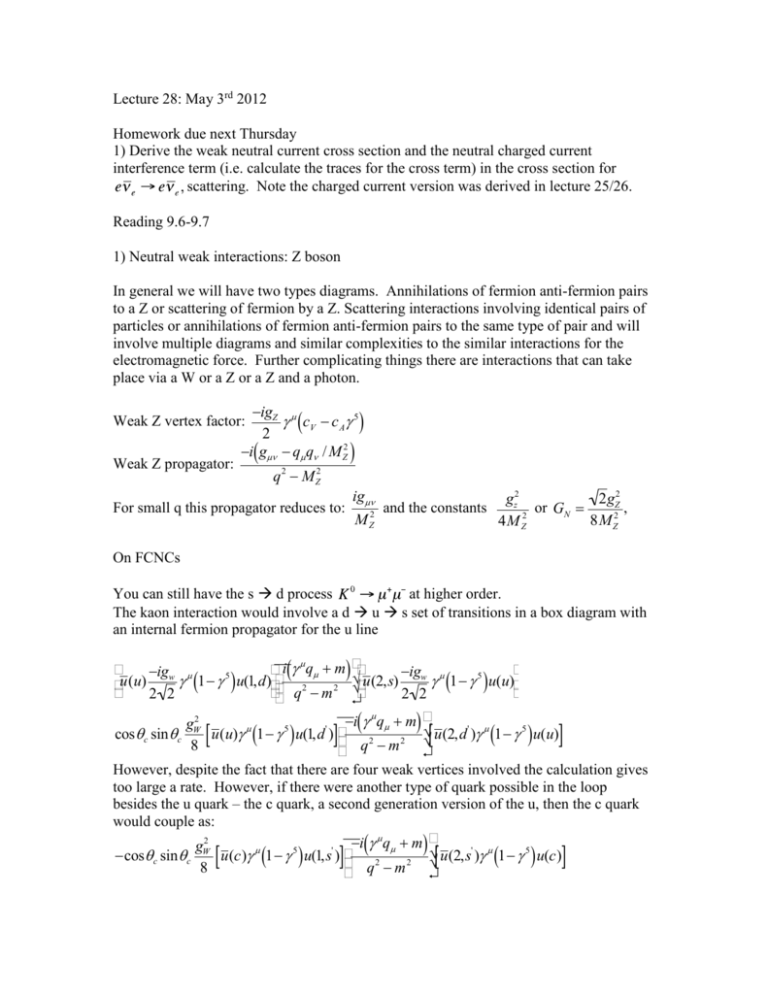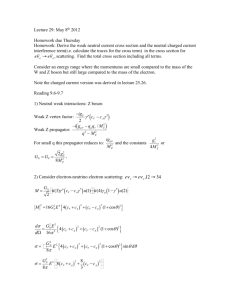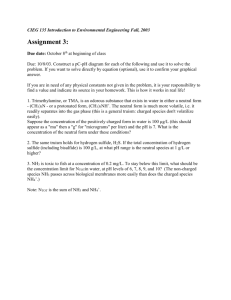lecturenotes2012_28
advertisement

Lecture 28: May 3rd 2012
Homework due next Thursday
1) Derive the weak neutral current cross section and the neutral charged current
interference term (i.e. calculate the traces for the cross term) in the cross section for
scattering. Note the charged current version was derived in lecture 25/26.
Reading 9.6-9.7
1) Neutral weak interactions: Z boson
In general we will have two types diagrams. Annihilations of fermion anti-fermion pairs
to a Z or scattering of fermion by a Z. Scattering interactions involving identical pairs of
particles or annihilations of fermion anti-fermion pairs to the same type of pair and will
involve multiple diagrams and similar complexities to the similar interactions for the
electromagnetic force. Further complicating things there are interactions that can take
place via a W or a Z or a Z and a photon.
-igZ m
g ( cV - c A g 5 )
2
-i( gmn - qm qn / M Z2 )
Weak Z vertex factor:
Weak Z propagator:
q 2 - M Z2
For small q this propagator reduces to:
igmn
2gZ2
gz2
and
the
constants
or
,
G
=
N
M Z2
8M Z2
4M Z2
On FCNCs
You can still have the s d process
at higher order.
The kaon interaction would involve a d u s set of transitions in a box diagram with
an internal fermion propagator for the u line
m
é
ùæ i(g qm + m) öé
ù
-igw m
-ig
5
÷êu (2,s) w g m (1- g 5 ) u(u)ú
g (1- g ) u(1,d)úçç 2
êëu (u)
2
ûè q - m ÷øë
û
2 2
2 2
æ -i(g m q + m) ö
gW2
m
m
5
'
÷ u (2,d' )g m (1- g 5 ) u(u)
cosq c sin qc
u (u)g (1- g ) u(1,d ) çç
2
2
÷
8
è q -m
ø
[
]
[
]
However, despite the fact that there are four weak vertices involved the calculation gives
too large a rate. However, if there were another type of quark possible in the loop
besides the u quark – the c quark, a second generation version of the u, then the c quark
would couple as:
æ -i(g m q + m) ö
gW2
m
m
5
'
÷ u (2,s' )g m (1- g 5 ) u(c)
-cosq c sin qc
u (c)g (1- g ) u(1,s ) çç
2
2
÷
8
q
m
è
ø
[
]
[
]
and cancel out the other terms, except in that the integrals over the internal momentum of
the u and c quarks are slightly different allowing for a small rate. In fact we see that 10
in 1 billion neutral kaon decays go to two muons. The combination of no tree level Z
contribution and the loop level contribution being suppressed in known as the GIM
mechanism.
In addition if you consider the interaction
, if you rotate this into the flavor
eigenstates you get
. The CKM matrix elements don’t
matter for the neutral current Z boson interaction.
For the charged weak W boson interactions we had experimental evidence that the
current was a pure V-A, cV = -cA interaction from maximal parity violation in nuclear
decays and the fact that the neutrino was purely right handed. This was not a given fact
until we performed the measurements. For the neutral weak Z boson interactions the
measurements indicate that not only do these interactions not have cV = -cA , but they are
different for each type of quark and lepton, u, d, e-, .
u: cV =
1 4 2
1
- sin qW ,c A =
2 3
2
1 2
1
d: cV = - + sin2 qW ,c A = 2 3
2
1
1
e-: cV = - + 2sin2 qW ,c A = 2
2
1
1
: cV = ,c A =
2
2
The GSW model of electroweak unification makes predictions for all these parameters.
For instance for the primary coupling constants and masses.
gw =
ge
ge
,gz =
, MW = M z cosq w,
sinq w
sin q w cosq w
and therefore GN =
q w =28.7
2gz2
2 cos2 qW gz2
2 cos2 qW gW2
2gW2
=
=
=
= GF
8M Z2
8M W2
8M W2 cos2 qW
8M W2
The relationship between the constants via the Weinberg mixing angle indicates some of
the physics. More on this later.
2) Consider electron-neutrino electron scattering:
é
ù ig
-ig
-iM = êu (3) Z g m (cV - c A g 5 ) u(1)ú mn2
ë
û MZ
2
é
ù
-igZ 1
5
êëu (4) 2 2 g m (1- g ) u(2)úû
Where I’ve put in the “known” factors for the neutrinos since there are only left(right)
handed (anti) neutrinos the g m 1- g 5 form can be used immediately.
Note that this matrix element is almost identical to the charged weak matrix element
except for the factors cV ,c A , and ½.
g2
M = Z 2 éëu(3)g m cV - cAg 5 u(1)ùûéëu(4)g m 1- g 5 u(2)ùû
8M Z
2gZ2
The terms in front can be identified with the neutral fermi coupling constant GN =
,
8M Z2
G
M = N éëu(3)g m cV - cAg 5 u(1)ùûéëu(4)g m 1- g 5 u(2)ùû
2
(
(
)
)
(
(
)
(
)
)
M =
*
*
GN2 é
m
5
n
5
5
5
ù
é
ù
é
ù
é
ù
u(3)
g
c
c
g
u(1)
u(3)
g
c
c
g
u(1)
u(4)
g
1g
u(2)
u(4)
g
1g
u(2)
( V A ) ûë
( V A ) û ë m ( ) ûë n ( ) û
2 ë
M =
GN2 é
u(3)g m ( cV - cAg 5 ) u(1)u(1)g n ( cV - cAg 5 ) u(3)ùûéëu(4)g m (1- g 5 ) u(2)u(2)gn (1- g 5 ) u(4)ùû
ë
2
M =
GN2 é m
Tr ëg ( cV - cAg 5 ) p/ 1g n ( cV - cAg 5 ) p/ 3 ùûéëg m (1- g 5 ) p/ 2g n (1- g 5 ) p/ 4 ùû
4
2
2
2
{
}
M =16GN2 (cV + c A ) ( p1 × p2 )( p3 × p4 ) + (cV - c A ) ( p1 × p4 )( p2 × p3 )
2
2
2
In CM frame
( p1 × p4 ) = ( p2 × p3 ) = -E 2 (1+ cosq )
( p1 × p2 ) = ( p3 × p4 ) = 2E 2
{
M =16GN2 E 4 4 ( cV + cA ) + ( cV - cA ) (1+ cosq )2
2
2
2
}
ds
1
1
2
2
=
16GN2 E 4 4 ( cV + cA ) + ( cV - cA ) (1+ cosq )2
2
2
dW 256p E
{
s=
ò
{
}
GN2 2
2
2
E 4 ( cV + cA ) + ( cV - cA ) (1+ cosq )2 sinq dq
8p
}
GN2 2 ì
8
2
2ü
s=
E í8 ( cV + cA ) + ( cV - cA ) ý
î
þ
8p
3
{
GN2 2
2
2
s=
E 3(cV + c A ) + (cV - c A )
3p
}
4GN2 2 2
s=
E {cV + cV c A + c A2 }
3p
However this interaction can also happen via the charged W and there can be interference
between the weak charged and neutral currents!
3) Electron-neutrino electron scattering: Z/W interference
However this interaction can also happen via the charged W and there can be interference
between the weak charged and neutral currents!
Consider the matrix elements again.
G
M = N u (3)g m c A - cV g 5 u(1) u (4)g m 1- g 5 u(2)
2
[
M=
(
[
) ][
(
][
]
)
]
GF
u (3)g m (1- g 5 ) u(1) u (4)g m (1- g 5 ) u(2)
2
where GN = GF
Note in this expression of the two matrix elements particle 3 and 4 for the W refer to the
neutrino and the electron rather than vice-versa. However, if we are neglecting the
electron and neutrino masses the sums over 3 and 4 spinors will be the same.
You can then just add the matrix elements
G
M = F u (3)g m (c A + 1) - (cV + 1)g 5 u(1) u (4)g m 1- g 5 u(2)
2
[
(
) ][
(
)
]
and write down the total cross section using the by substituting
Comparing:
4 2 2
4GF2 2 2
s W = GF E , s Z =
E {cV + cV c A + c A2 }
p
3p
4GF2 2 2
4G 2
4
E {cV + cV cA + cA2 } + F E 2 {cA + cV } + GF2 E 2 ,
3p
p
p
one can see the interference term.
s=
Note the W term was isotropic, the Z term had an angular distribution and we don’t yet
know in the case of the interference term. Let’s evaluate the cross term to verify this
result and derive the angular dependence:
Must be careful to label the particles the same in this case!
G
M Z = N éëu(3)g m cA - cV g 5 u(1)ùûéëu(4)g m 1- g 5 u(2)ùû
2
(
)
(
)
MW =
GF é
u(4)g m (1- g 5 ) u(1)ùûéëu(3)g m (1- g 5 ) u(2)ùû
ë
2
M =
GF2
u (3)g m (cV - c A g 5 ) u(1)u (1)g n (1- g 5 ) u(4)u (4)g m (1- g 5 ) u(2)u (2)g n (1- g 5 ) u (3)
2
M =
GF2 é m
Tr g ( cA - cVg 5 ) p/ 1g n (1- g 5 ) p/ 4g m (1- g 5 ) p/ 2gn (1- g 5 ) p/ 3 ùû
4 ë
2
2
[
]
Looks difficult!
n
m
5
n 5
m
n 5
m
5
n
é m
ù
GF2 ê(g cV p/ 1g p/ 4 + g cAg p/ 1g g p/ 4 - g cV p/ 1g g p/ 4 - g cAg p/ 1g p/ 4 )ú
M =
Tr
ú
4 ê(g m p/ 2g n p/ 3 + g mg 5 p/ 2g n g 5 p/ 3 - g mg 5 p/ 2g n p/ 3 - g m p/ 2g ng 5 p/ 3 )
ë
û
2
m
n
m 5
n
é
ù
GF2 ê2 ( cV + cA ) (g cV p/ 1g p/ 4 - g g p/ 1g p/ 4 )ú
M =
Tr
ú
4 ê(g m p/ 2g n p/ 3 - g mg 5 p/ 2g n p/ 3 )
ë
û
2
[
]
Terms with an odd # of gamma 5’s will contract to Tr g 5g b g d = 0. Trace 15.
M =
GF2 é
Tr ë2 ( cV + cA ) (g m cV p/ 1g n p/ 4g m p/ 2gn p/ 3 + g mg 5 p/ 1g n p/ 4g mg 5 p/ 2g n p/ 3 )ùû
4
M =
GF2
4 ( cV + cA ) Tr éëg m cV p/ 1g n p/ 4g m p/ 2g n p/ 3 ùû
4
2
2
See HW9 7.37
M = 64GF2 (c A + cV )( p1×p2 )( p3 ×p4 )
M = 256GF2 ( cA + cV ) E 4
Same exact form for the W and the Z/W term except multiplied by (c A + cV )
4) Given these results one could compare various scattering cross sections.
Comparing:
4
4G 2
4G 2
s W = GF2 E 2, s Z = F E 2 {cV2 + cV c A + c A2 }, s WZ = F E 2{c A + cV }
p
3p
p
s W +Z =
4GF2 2 2
4GF2 2
4
E {cV + cV c A + c A2 } +
E {c A + cV } + GF2 E 2,
3p
p
p
by only Z
by only W
by both W and Z
The Z only process has an angular dependence:
ds GF2 2
2
2
=
E 4 ( cV + cA ) + ( cV - cA ) (1+ cosq )2 sinq
dq 8p
{
}
Given this pattern of results one can propose a set of simple experiments to extract cV and
cA for the charged leptons.
Use a beam of medium energy neutrinos so that the approximations q<<MW,Z and
q>>me, can be applied. Muon neutrinos so that scattering interactions that result in final
state electrons only involve the Z and process.
From the angular dependent part of the
(cV - c A ) = s a
cross section:
p
3GF2 E 2
From the isotropic part of the process.
p
(cV + c A ) = s i 2
GF E 2
By taking the ratio of these processes to the
dependence on GF and energy.
s Z /s W =
via the W you can eliminate the
1 2
1æ1
1
1ö
cV + cV c A + c A2 } = ç - 2sin 2 qw + 4 sin4 qw + - sin 2 q w + ÷
{
3
3è 4
4
4ø






